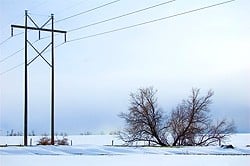The freak October snow storm that knocked out power to hundreds of thousands of people in the northeast was a rude awakening that winter is upon us, and that losing power in the colder seasons is quite uncomfortable to say the least. But, it is also a reminder how people who had invested in solar electric systems with battery banks are the fortunate ones to weather the outage and likely do so without even a blink in their lights. But not everyone with solar panels on their home would’ve been spared from this power outage…
Solar panels have dropped more than 50% in price in just the last 2 years alone. This drop in prices, in conjunction with the state and federal rebates and tax incentives, have made solar electric systems more compelling than ever to install on your home. As a result, more home owners than ever have been taking advantage of these incentives by installing solar on their homes.
However, to keep costs down and create simplicity for the solar installer, many homeowners only opted for solar electric systems that don’t have the components for providing backup power when the electric grid goes down. Those components include such things as a battery bank, solar charge controller, assorted breakers and instead of a grid-tie only inverter having an inverter that’s also capable of working with a battery bank to provide backup power in exactly these scenarios. So it’s a shame, so many homeowners have fully functional solar power systems that produce enough power for at least the most urgent of appliances and electric devices in the home (if not everything) but it can’t be utilized during a blackout.
Fortunately, with the advent of a new type of solar charge controllers (such as the Xantrex 80 Amp MPPT Solar Charge Controller) that can support the high voltages from a typical grid-tie solar panel array, upgrading your system to support backup power doesn’t mean you have to start from zero. It would mean swapping out your grid-tie-only inverter for one that’s capable of grid-tie and backup power, a high voltage solar charge controller (like the one just mentioned), appropriate breakers and disconnects, and a battery bank sized to your preference and cables. You won’t need to change your solar panels, their configuration, nor the connection to the utility company. Of course, you’d want to employ a licensed electrician to make this change out to ensure that it is done safely and according to electrical code.

